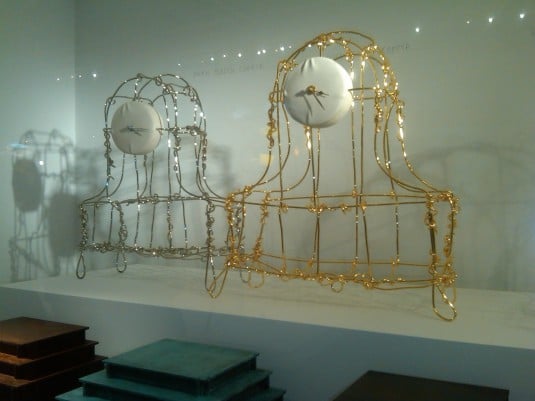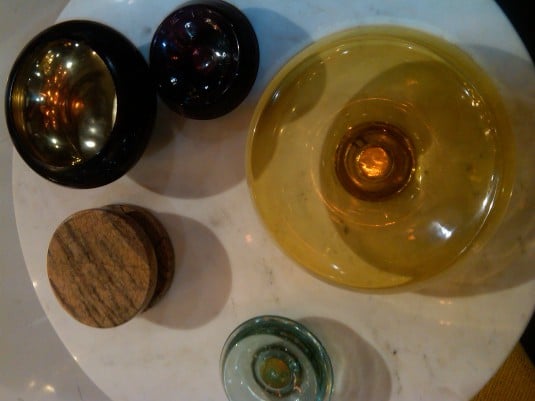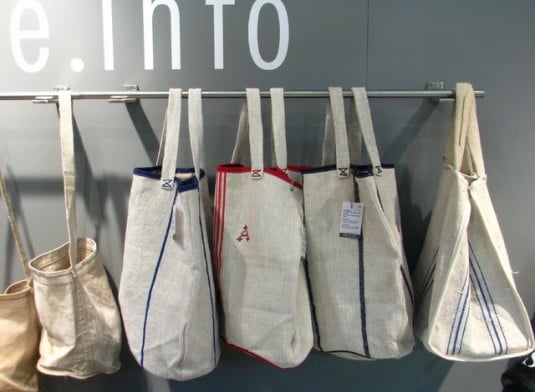
May 31, 2011
Trending Green
While in our previous post we expressed our disappointment in the home furnishings market for the level and amount of green and sustainable designs we saw at ICFF and the satellite showrooms, we also saw many signs of life and innovation, proving that there are deep trends afoot which promise to provide the way for […]
While in our previous post we expressed our disappointment in the home furnishings market for the level and amount of green and sustainable designs we saw at ICFF and the satellite showrooms, we also saw many signs of life and innovation, proving that there are deep trends afoot which promise to provide the way for others to follow.
Trends we saw range from Green Transparency, reflecting the industry’s need to develop its own LEED certification similar to the one used by the architectural building industry or Green Connection which features a Berlin-based clothing collection that digitally traces and connects its owners or the steadfast Green Lure of the Timeless, sparked by a conversation with a family member of Austria’s sixth-generation glass dynasty, Lobmeyr, and a locally grown trend we call Green, Hot In My Backyard (HIMBY).
Juergen Mayer H. at “$H!T Happens in Berlin.” Photo: Paul Clemence.
Green Transparency: “It’s not just an element of décor anymore,” said Brian Greenberg, of the material surfaces sold by his family-run business, Relative Space. The company produces carpet and wood surfaces that are born of intensive research into every change of custody in the supply chain and resource conservation. Their exhibits, like the one up during ICFF week, stimulate the public with slogans like “$H!T Happens in Berlin”, curated by Brian’s son, Tyler Greenberg and architect, Jurgen Mayer H. The standards at Relative Space are rigorous and convey quality. Wood goes through minimal processing during manufacture, installation, and planned for future disassembly. Biocides in the stain control off-gassing and no vinyl backings. Design highlights included wood-patterned carpet flooring with embedded LED lights for security and transparent wood, so thin as to accommodate the tiny lights for signage or pattern.
 Schmidt Takashi, photo: Paul Clemence.
Schmidt Takashi, photo: Paul Clemence.
Green Connection, All in the Cloth: Schmidt Takahashi from Berlin, part of the exhibition at Relative Space, picks up the pieced-recycled clothing trend while taking the personal connectivity a step further with digitally-scanable codes on hangtags. This is done to connect the wearer with the past owner’s incarnations, recorded experiences in the garment–essentially the lineage of each vintage piece that makes up the new garment. This touchy-feely connection between people is the new green connection we see as values that can positively impact the planet. It’s the depth of the green consciousness that has become fun and innovative rather than a chore. As architect Jurgen Mayer H., co-curator of the show whose own work investigates new aspects of human interaction in the new digital world, put it, “The question is, are we alone or alone while connected?”
 “One More Time” at Moss, photo: Jade Dressler.
“One More Time” at Moss, photo: Jade Dressler.
Green Connection, All in the Family: Dutch designers, Kiki van Eijk and Joost van Bleiswijk, a husband and wife duo, showed at Moss’s “ONE MORE TIME” exhibit during New York Design Week. They get points for sustainability for creating limited edition heirloom clocks and also for their joinery treatments: no glue, no nails; a trend we reported on in our previous post. Kiki’s clocks are wiry, sinuous, feminine contemplations while Joost’s angular metal abstractions. Both benefited from Murray Moss’s vision to offer them in a range of colors and treatments increasing their value as collectibles, things worth treasuring.
 Tom Dixon’s pulls, photo: Jade Dressler.
Tom Dixon’s pulls, photo: Jade Dressler.
Green Connection, All in the World: Tom Dixon’s large circular or bowl door-pulls, hooks or cache pots are an engagement with the extreme for an otherwise unconscious act of connecting with our built environment. A quote from his book, Extremism, resonated with us: “Given the current state of consumption, new stuff must have a superior reason for existing. Not only that, but the way we make and sell it must be refined. Extremism is a celebration of the intense and purposeful; a reflection on the things that leave the most impact.” This, in turn, reminded us of the famous saying from The Great Law of the Iroquois Confederacy, “In our every deliberation, we must consider the impact of our decisions on the next seven generations.”
Green Lure of the Timeless: Invited by Wien Products to view the latest in Austrian design, we were most taken by J.& L. Lobmeyr, family-run for centuries, producing many of the same designs from the 1800’s, year after year, heirlooms valued all over the world for their timeless perfection. The personal energy of the maker includes the owners living next to the atelier in an apartment with full view of the makers arriving each dawn for work. When asked how he plans to grow the company to follow in the footsteps of, say, a Swarovski, Johannes Rath managing partner of Lobmeyr, answered, “I don’t.” Small, precious and craftsman oriented is this old/new tradition. Design-guru retailer, Murray Moss added, “When you go from a normal glass to this, it modifies your behavior. You become more graceful. And that’s an extraordinary thing to get from seventy dollars.”
 Totes by Arxe. Photo: Paul Clemence.
Totes by Arxe. Photo: Paul Clemence.
Green Allure of the Ancient: Flax, a fiber used for centuries, comes from a plant that rejuvenates soil and has a low pesticide requirement compared to cotton (calling all organic farmers!). Because of the fiber’s strength, there is a lot of vintage linen around to make into new products. This cloth re-use trend began to appear several years ago. At ICFF Arxe from Spain displayed a sensual world of simple, hand-wrought textural epiphanies fashioned from salvaged antique industrial materials such as steel, wood, leather iron and vintage linen. The hand, the experience of the maker and user is the value of objects here honoring the ancient, the timeless.
Green, Hot In My Backyard (HIMBY): NIMBY (Not In My Back Yard) became the catch phrase in the 1980s when people began to wake up to the nasty kind of neighbors that giant manufacturing, agri-business, and nuclear plants made. Now we can focus on what we desire back in our communities: small, homegrown, clean industries and jobs– HIMBY or Hot In My Backyard.
Olga Guanabara’s table and pillows. Photo: Olga Guanabara.
In Manhattan’s backyard of DUMBO lives Olga, the brown lab and his owner Richard Velloso, a former ad exec turned craftsman, in Olga Guanabara, where adaptive re-use custom furniture is designed and built in a large showroom they opened in time for ICFF. The web site features a bit of copy-writing via Olga’s commentary, speaking to why Homegrown, Connection, and Community are hot green design trends.
 Harry Allen furniture. Photo: Paul Clemence.
Harry Allen furniture. Photo: Paul Clemence.
The rainforest’s backyard in Brazil: Seen at the show, NDT (No Da Terra), Brazil, is a rural manufacturer of furniture made from reclaimed or certified wood and reflective of the bright colors and versatile shades of Brazil’s rural culture. Ricardo Augusto, the architect and owner, partnered with a furniture factory that specializes in working with wood recycled from construction sites or demolitions. The collaboration with well-known American designer Harry Allen, and Brunno Jahara for ICFF featured designs crafted out of rough, aged wood. The result brings the tree, the object, and user closer by inviting one to touch and feel the pleasing textures.
All the inspiring ways we saw during New York Design Week can help us think of new ways to live harmoniously with our planet and design things that reveal their processes, material sources, manufacturing to us. We know, instinctively, that we need to reconnect with the natural world that give us life, with each other, and with our human spirit. Our furnishings, some of the most intimately personal objects we are likely to buy, can help us make these deep connections.







